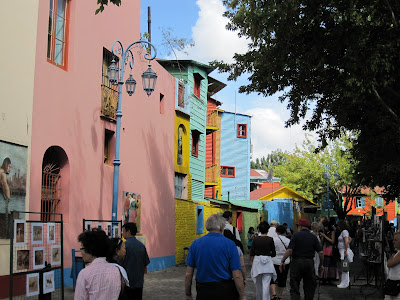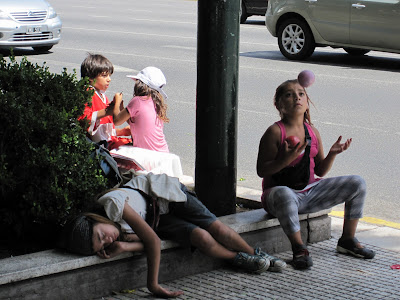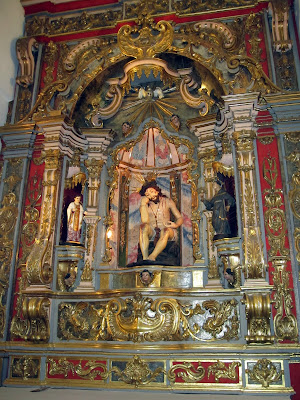We enjoyed two great sea days and Jim continued to get better. March 4 is always a special “anniversary” for us, as it marks the day we began seeing each other. We were joking with Barb and Ed about our anniversary, and lo and behold, a lovely flower arrangement appeared from them.
Some special roses from my hubby…
And a baby duck (I think?) from Gina…
It was a beautiful sunrise sailing into Buenos Aires. B.A., as it is known here, was founded in 1536 in a malarial, swampy area. It only developed as a major city many centuries later, and for this reason does not have any of the old colonial buildings that are common in other South American cities. Instead, much of the city’s architecture is modelled after the French and the city is known as the “Paris of the South.” Argentina gained its wealth from the many estancias (ranches) that dotted the countryside making it one of the biggest meat and grain producers in the world.
A huge port...
With very modern skyscrapers…
Jim stayed on board as he continued to recuperate. I caught him waving from our balcony as we left the port. You can see him in the little circle at the front of the ship with the bridge directly above us.
A very new port terminal…
We were joining a group of 12 Cruise Critic people on a private tour, and after finally locating our guide, we were off in the busy city. The population of greater Buenos Aires is 11 million.
Part of the very busy Retiro area...retiro means to leave and the train station, bus station and subways are located here. It’s not necessarily a desirable area of the city, but a very important one.
Pretty impressive train station…Estacion Retiro!
Our new trees to admire…we have seen them in several of the South American countries. Our guide, Marcelo, is very knowledgeable about the history of the city, but admits he’s not as good in botany and isn’t sure of the name of the tree.
At one time this was a private home, but is now a government building…
The obelisk in the distance is a similar idea to the Arc de Triomphe in Paris in that many roads lead off it…
Manzana de las Luces, one of the two important buildings with Spanish architecture in the city.
Catedral Metropolitana…
Hardly what we think a Catholic church would look like.
The relief represents the reunion of Joseph with his brothers and father in Egypt.
The interior is beautiful...
It must have taken years to make the endless mosaic floor…
Every alcove with a different story…
The figure in glass replicates the painting above…
The tomb of General Jose de San Martin, draped in the Argentine flag, is guarded by three female statues that represent Chile, Argentina and Peru, three of the regions freed by him.
And guarded as well by real-life soldiers…
What a glorious day!
Our guide, Marcelo, graduated from a four-year program in tourism. He is definitely one of the best tour guides we have ever had. He told us that when he was a child, his mother made him take English classes every Saturday morning for two hours from the time he was 7 until he was 18. He hated every minute of it, but now is very happy that he did it. Smart Mom!
Oh yes, it’s all fun and games until you feed them…
Piramide de Mayo is the oldest national monument in B.A. Most demonstrations and protests take place in this square. In the background, you can see some signs for a current protest for the Argentinians who were part of the Falklands War, but did not receive any compensation.
The white scarves around the outside of the circle commemorate the Mothers of the Plaza de Mayo. They marched here every Thursday at 2:30 from 1983 to 2005 to protest the disappearance of many young people who dared to speak out against the government at that time.
The Casa Rosada (Pink House) and the Cathedral are at the heart of Argentina’s administrative and religious centre. The Pink House is to B.A. what the White House is to the US, the office of the president. The colour was originally achieved by mixing beef fat, blood, and lime. It is blocked off from the Plaza de Mayo by a fence to prevent any protests being held in the Plaza from getting too close.
Outside the fence…the balcony above the main entrance in the centre was normally where the President would speak from, but because Eva Peron wanted to be close to her people, she gave hers from the balcony on the left (circled).
Our group with Marcelo…we had an amazing full day tour.
A flat iron building…
And then it was on to La Boca. Doesn’t this look beautiful and serene? You cannot imagine the unpleasant smell that was coming from here! It was originally the main port of the city on the River Riachuelo.
La Boca is famous for its colourful houses and for being the birthplace of the Tango. The area was settled mostly by Italian immigrants who painted their houses in bright colours with leftover paint from the ships in port. It is the home of the Boca Juniors, one of the world's best known football (soccer) clubs. It would have been a very rough and poor neighbourhood, as much of it remains today.
In 1917, handsome Carlos Gardel recorded a tango called “Mi Noche Triste” and instantly became a superstar all over Latin America. He is said to be single-handedly responsible for introducing the sensuous words, movements and music to the rest of the world, but his career was cut short by a plane crash in 1935. You can see his picture with his trademark fedora all around B.A.
Benito Martin was a famous Argentinian painter whose work showed La Boca with all its vibrant life (good and bad).
It was a Sunday and the area was full of tourists. I asked Marcelo if he ever comes here and he said “No, it’s a place you come to once."
Very unique…full of artists…
There were some lovely paintings, but I stuck to my new motto of “admire and move on.”
Trompe l’oeil in the top left corner…
Great place for pickpockets as we were warned many times.
Famous Argentinians on the balcony…football player, Diego Maradona; Eva Peron; and Carlos Gardel, the founder of the tango.
These pots are for the local drink of maté. You put the leaves of the yerba maté plant in and fill it with hot water. You sip it through the silver straw, which has an infuser on the end. Marcelo said you cannot buy this in a café or restaurant because there is no price on it. It is a drink you enjoy with friends. If 3 people were having it, the first would drink some and refill it with hot water, and pass it to the second person and so on. It is quite bitter, an acquired taste!
Come hither…
These tango dancers were outside several cafés in an attempt to attract the visitors. I wish we had had more time. It would have been great to just sit and watch.
One of the many little stores…we bought some postcards and some stamps. The stamps were not government issued, but from a shipping company (like our UPS). Marcelo said it was good that we bought those kinds of stamps as they would actually get mailed. Many times other mail is just not delivered.
Maybe a little touristy?! But fun!
Havanna is a company that makes Argentine chocolate treats.
You had to walk over these sleeping dogs to get into the store, but Ed braved it and bought us each one.
Ed, Barb and I at La Boca…
Graffiti everywhere…some nice, some just messy.
Cobblestoned streets…the government decided to get rid of them and paved over them. The people were so outraged that they had lost a piece of culture, that the government then paid to remove the pavement. Marcelo figured some paving company probably had an “in” with the government to get the contract in the first place. It sounds like there is still quite a bit of corruption.
We stopped at this restaurant for a “snack” and a drink. It was supposed to be a quick stop, but it turned into 90 minutes which was fine with us. Argentinians are known for their long meals. They can spend an hour with a small cup of coffee, and do not have takeaway coffee as it just isn’t part of their culture.
Yay! A break…I had an omelette which was very good. Argentina is known for its fine beef so several people had huge steaks. It is a rare day when an Argentinian does not eat steak, and they eat very late at night, usually 10:30. Most restaurants do not open in the evening until 9:00 p.m.
More beautiful trees…
This guy pulled up next to us and motioned for me to take his picture. So I did, much to his approval!
Some impressive graffiti…
This is Avenue 9 de Julio with 10 lanes of traffic in each direction. Argentinians boast that it is as wide as any of the streets in the world’s great cities.
Walking across the avenue can take you several walk lights and you do it in stages.
These kids were in the middle of the avenue. They were sort of sad…the two in the back were fighting, one was sleeping and one was throwing the ball up and down. Makes you wonder what their story is.
And we stopped in the middle for a group photo…
The back of the Colon Theatre, one of the world’s greatest opera houses with six gilded tiers and amazing acoustics.
And the front…sadly, it has been closed for several years, except for tours. It was closed initially for renovations and now because of union disputes.
Behind the monument you can see a new building built right up next to an old one. That must have cost a fortune to build around it.
A public school…doesn’t look like any of our public schools! University is free in B.A. unless you choose to take a course outside the normal lawyer, doctor, etc.
This tree he did know…it is their national tree, the ombu, and is part of the banyan family. The roots are huge!
This church is the other Spanish architecture building in B.A.
Opposite a very modern corner…
We passed by another ombu tree. They have propped the branches up so that the space under the tree is usable.
The church is right at the entrance of the Recoleta Cemetery, which contains the graves of many important Argentinians.
It is very ornate inside…
They were selling maps of the cemetery, which you would need if you were on your own.
Endless “streets” of mausoleums…you cannot imagine how hot it was in there. No grass, just lots of concrete and marble to suck up the sun.
And lots of cats…they keep the rat population down.
Some very moving monuments…
Pictures of funerals on the outside of the mausoleum…
If you peeked in the mausoleums, you would most often see two caskets. These would hold the bodies of the heads of the family…
Each mausoleum has a basement. When it gets full of caskets, a body is removed and cremated and stored elsewhere inside, to make room for another family member. The two caskets on the main level are never touched, however.
Awww…these poor kitties. He kept meowing when I talked to him. Ed petted him much to Barb’s chagrin. Much as I love cats, I refrained! The poor little guy probably hadn’t had any human attention for a long time.
Many of the mausoleums have beautiful stained glass. You can see that this one is falling into disrepair. If you haven’t paid your taxes for 40 years (that’s a lot of leeway), the bodies are removed and the mausoleum is sold at a high price. It’s a very desirable place to be buried.
A very modern mausoleum with the full glass door.
This tomb is interesting because it has both a Christian cross and a Jewish menorah. It is meant to show the religious conversion the family made when they moved to Argentina in the 16th century.
This headstone outside the mausoleum was for a cherished servant. Although they couldn’t be buried inside with the family, they were obviously highly thought of.
You could spend days wandering around and looking at all the amazing statues…
Can you feel the heat radiating off the pavement?? It was stifling.
Marcelo spent quite a bit of time explaining this tomb. You can see how many people were sitting by now...the heat was killing us! Aldolfo Alsina was the Governor of B.A., but it was as the Minister of War that he made his mark. He built 109 lookout points all defended by trenches in what was indigenous territory. He wanted to lay claim to fertile soil for ranches and drive out the Mapuche people. The relief on the left shows the Mapuche people fleeing, while the one on the right shows the troops advancing.
This lady’s husband posted a notice in the paper saying he would no longer be responsible for her debts. She was so humiliated that when she died after he did, she asked to have her statue facing away from him. He is in a chair and resting, but she is still not at rest. Notice the bags under the eyes…you would usually be portrayed in a favourable way, but it appears that he still got the best of her.
Famous boxer, Luis Angel Fippo…
The largest mausoleum in the cemetery…
This one is very neglected…
And the most famous…Eva Duarte Peron, who is either loved or hated in Argentina. Her body once disappeared for 16 years and she is now buried under several feet of concrete to prevent a repeat occurrence.
This plaque was placed to mark the 30th anniversary of her death…
This is one of the saddest stories…a wealthy family preparing to go to the opera, found their 19 year old daughter dead. They buried her the next day, and when her uncle came several days later to pay his respects, he noticed that the casket had moved. They opened it up and found it full of claw marks. She had been in a catatonic state, not dead, and was therefore buried alive.There are many variations on what the statue represents. One of them is that she is escaping from the tomb...I liked that one the best.
On that happy note, we left the cemetery…
From here, Marcelo said “How would you like to see the second most beautiful bookstore in the world?” Sure, why not?! El Ateneo used to be an opera house.
The balconies hold different sections of books, and you can take any book into one of the theatre boxes and read.
The stage is now a café where the Argentinians love to linger and have coffee.
It is beautiful…
And then it was back to the van...Barb waving...
Palacio Paz was originally the home for 6 people and 60 servants. It is now a club for retired military officers.
Looked like an earthquake but the upheaval was caused by the tree roots.
Another unique private home…
And our amazing tour ended in Plaza San Martin…this statue of General Jose San Martin was the first equestrian statue in Argentina. Each of the statues in the corners represents a different milestone in the battle for independence. He was one of the greatest heroes in their history, responsible for gaining independence for Argentina, Chile and Peru.
The Kavanagh building was commissioned by Corinna Kavanagh, an eccentric heiress of Irish ancestry. She wanted the building as an investment income and was quite the visionary. She could not afford a French or Italian architect, and so it was designed by a local group and constructed from 1934-1936. It was the tallest building in South America at the time, and the first in the world with air conditioning. The Argentinians were initially appalled by the building and hated it, but it is now one of the most expensive and sought after apartment buildings in the city. It was declared a National Historical Monument in 1999.
And our last stop...the Argentine monument to the Falkland Islands or Las Isla Maldivas as they are known here. This war occurred during the "Dirty War" in Argentina when they were under a dictatorship and the people were oppressed and unhappy. It was thought that reclaiming the Falklands would lift everyone's spirits, but that didn't happen.
It was an exhausting, but absolutely amazing day. I was so tired, I forgot to take a picture of the "next port sign!" Next stop...Montevideo, Uruguay!


























































































































No comments:
Post a Comment